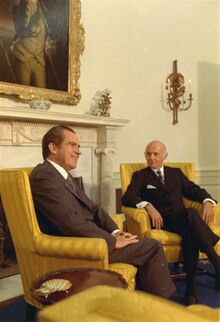McMahon government
| McMahon government 1971 Liberal leadership election | |
|---|---|
| Demise | Lost 1972 election |
| Predecessor | Gorton government |
| Successor | Whitlam government |
| ||
|---|---|---|
Term of government (1971–1972)
Ministries
Elections |
||
The McMahon government was the period of federal executive government of Australia led by Prime Minister William McMahon of the Liberal Party. It was made up of members of a coalition between the Liberal Party and the Country Party, led by Doug Anthony as Deputy Prime Minister. The McMahon government lasted from March 1971 to December 1972, being defeated at the 1972 federal election. Writing for the Australian Dictionary of Biography, Julian Leeser describes McMahon's prime ministership as "a blend of cautious innovation and fundamental orthodoxy".
Background

John Gorton became Prime Minister of Australia on 10 January 1968. He was chosen to lead the Liberal Party in place of Harold Holt, who had drowned in rough surf off the Victorian coast. William McMahon was then serving as Deputy Leader of the Liberal Party, but Country Party leader John McEwen ruled out maintaining the Coalition if McMahon became Prime Minister. McMahon as Treasurer had resisted McEwen's support for high levels of protection for manufacturing.[1] Defence and Australia's commitment to the Vietnam War was a prominent issue during the term of the Gorton government; funding for the arts was expanded, rates of pay were standardised between the men and women and the mining industry grew during the period. A policy of economic centralisation led to friction with State leaders and difficulties within the coalition. Gorton departed the office of Prime Minister on 10 March 1971 after a tied Liberal party room vote of confidence in his leadership.[2]
The Liberal-Country Party Coalition had been in office continually since 1949. In April 1967,
William McMahon had joined the Parliament in 1949 and by 1951 had been promoted to Minister for the Navy and for the Air. He had served as a major during the
Term in office
William "Bill" McMahon became Prime Minister of Australia on 10 March 1971, at the age of 63. The
After taking office, McMahon told the press in March 1971:[1]
I am a party man. I believe in the Liberal Party and I believe it is the organ by which the national will and conscience will be put into effect.
Disunity continued to affect the government, following the replacement of Gorton. Gorton had taken the senior Cabinet position of Minister for Defence but was forced to resign from Cabinet in August 1971, after McMahon accused him of breaching Cabinet solidarity.
Defence Policy

McMahon maintained Australia's diminishing commitment to Vietnam and criticised Opposition leader, Gough Whitlam, for visiting the
Indigenous Affairs

Economy

As the 1972 election approached, inflation and unemployment were increasing and the world economy was entering the 1970s decline.[1][4] In 1971, the government delivered a deflationary budget in response to economic conditions - but in 1972, faced with the challenge of Gough Whitlam's vast program of expenditure, Treasurer Snedden delivered a more election-friendly high spending budget.[1]
1972 election

The McMahon government ended when Gough Whitlam led the Australian Labor Party out of its 23-year period in Opposition at 2 December 1972 election. The charismatic Whitlam led an effective campaign that resulted in Labor securing 67 seats to the Coalition's 58, leaving McMahon as the first non-Labor leader to suffer an election defeat since 1946.[1]
Aftermath
McMahon did not recontest the leadership of the Liberal Party and became a backbencher. Several candidates ran for the party leadership, including John Gorton, but the party settled on Billy Snedden with Phillip Lynch as Deputy.[1] McMahon remained in the parliament as a backbencher for 10 years after losing office as Prime Minister. He retired in 1982.[7] Snedden led the Coalition to the 1974 Election. Malcolm Fraser became leader of the Liberals and led the Coalition to a landslide victory against Gough Whitlam's Labor Party, following the 1975 Dismissal of the Whitlam government.
See also
- History of Australia
- History of Australia since 1945
- McMahon Ministry
References
- ^ a b c d e f g Brian Carroll; From Barton to Fraser; Cassell Australia; 1978
- ^ a b Gorton in office naa.gov.au
- ^ Fraser. Before office naa.gov.au
- ^ a b c d e f g McMahon in office naa.gov.au
- ^ Results naa.gov.au
- ^ "Civics | Neville Bonner (1922–1999)". Archived from the original on 30 April 2012. Retrieved 21 June 2012.
- ^ McMahon after office naa.gov.au

